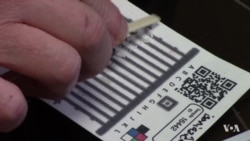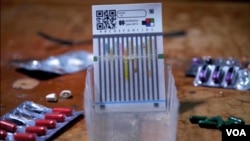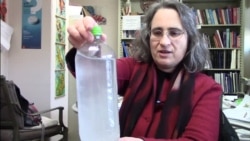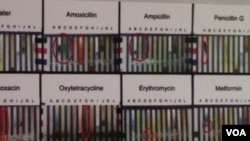Whether it’s brake fluid in Nigerian teething syrup, melamine in Chinese baby formula, or talcum powder in Kenyan antibiotics, contaminated food and medicine is a deadly problem. But a group of scientists, led by Notre Dame chemistry professor Marya Lieberman, hopes to eliminate the problem for millions of people in developing nations by offering a simple solution.
A ‘lab on paper’
The PAD - or Paper Analytical Device - project began six years ago as a collaboration between Notre Dame and St. Mary's College. The simple invention replaces expensive machinery that might not be available in developing countries.
Each of the 12 lines on the paper card is laced with a different chemical. When medicine is smeared across the lines and the card is soaked in water, a color change indicates whether the drug is safe. Drugs can be tested at any stage of the distribution process.
While not all alterations are deadly in and of themselves, not getting the right medicine or the correct dosage can still have fatal consequences for severely ill patients. “One in ten children who go to the hospital with pneumonia in Kenya don’t make it out,” Lieberman notes. “That’s because there is kind of a golden hour for patients to recover. If they don’t get the needed medicine in the correct dose, bacteria take over and they won’t make it.”
During a trip to Kenya last year, her team discovered amoxicillin caplets cut by half with talcum powder. In that case, they devised a simple water test to check for purity.
See the difference between a pure drug and one cut with talcum powder:
But most contamination cases need a more comprehensive test to discover errors.
A world of contaminants
In addition to testing pharmaceuticals, Lieberman’s team is developing cards to test lead, iodine, and even urine.
Notre Dame graduate student Jamie Luther is working on a card to identify contaminants in milk. "There are tests that are published for people at home to mix chemicals to test their own milk,” she says. “I thought to myself, that’s so cumbersome. People shouldn’t be handling acids in their home. They shouldn’t mix dangerous chemicals with their hands."
In order to discover the most common contaminants, Lieberman’s team works with 18 universities throughout the U.S. The labs use High Performance Liquid Chromatography (HPLC) machines to test drugs gathered from pharmacies throughout the developing world.
Notre Dame graduate student Nicholas Myers never considered what a big problem altered pharmaceuticals were before he started working on the project.
"I just took it for granted that chemical analysis could happen anywhere,” Myers admitted. “I didn’t know the extent to which low and middle income countries did not have the capacity to do chemical testing."
Veripad, a New York startup company is developing a complimentary smartphone app to help read and evaluate the cards. Because less experienced testers may not fully understand color results, and some may be color blind, the app takes away the guesswork. Testers can take a photo with their phones and get almost instantaneous results.
Lieberman says if there’s one thing this project has taught her, it’s that it’s sometimes necessary to look at a problem from a new angle to find the best answer. "If we can’t increase the capacity of analytical labs in the developing world,” she observes, “maybe we can come up with a way to bring that technology in a portable form that will be usable in the field."
The World Health Organization says a functioning health care system should have 343 pharmaceuticals on hand. So far, Lieberman’s team has developed PADs to identify 60 different drugs and eventually hopes to have tests for them all.








